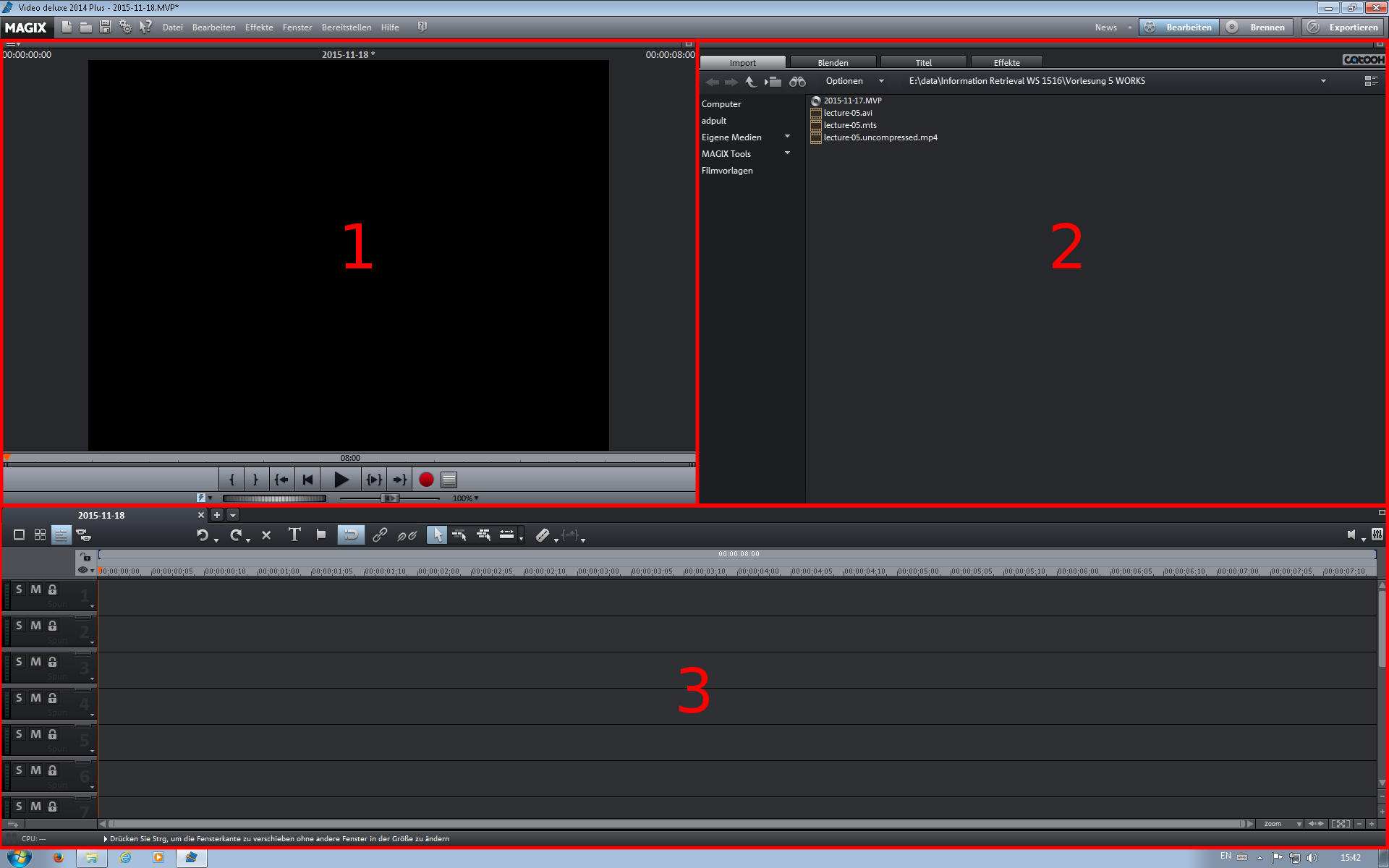|
Size: 196
Comment:
|
Size: 4477
Comment:
|
| Deletions are marked like this. | Additions are marked like this. |
| Line 1: | Line 1: |
| = Video Editing (with Magix Deluxe) = | = Video Editing (with Magix Video Deluxe 2014) = |
| Line 3: | Line 3: |
| This description refers to Magix 2014. | == Login == |
| Line 5: | Line 5: |
| Import MTS problem: MTS importieren -> unten Auswählen -> Effekte -> 3D Stereo -> auf Standard (2D) umstellen. | ==== Computer ==== {{{render.informatik.uni-freiburg.de}}} (hereinafter referred to as ''render''). ==== Login ==== * Locally in room 051-03-?? * Per Windows Remote Desktop Connection (RDC). * Start ''render'': {{{wakeonlan render.informatik.uni-freiburg.de}}}. * Shutdown ''render'': {{{shutdown -s -t 0}}} (in the command-line of ''render''). === Account === Login: {{{adpult}}}, Password: (the common one). == Files == Typically, there is a camtasia file (''avi'') and a video file (''mts'') for a single lecture. Copy ''avi'' and ''mts'' from the raid ({{{\\atlantis\teaching}}}) to ''render'' (for example, to {{{E:\data\<course>\<lecture-X>\}}}). == Magix Video Deluxe 2014 == === Create new Project === Start '''Magix Video Deluxe 2014''' (not Magix Video Deluxe 17). Choose "Neues Projekt erstellen" and type in a project name. Click "Optionen". Check "Neuen Projektordner anlegen" and choose the project folder (that is typically the same folder where you have saved the video files). Choose "Filmeinstellungen -> Benutzerdefiniert (Filmeinstellungen öffnen)" and "Audio-Samplerate -> 48000". Click OK. In the next window, check "Anzahl der Spuren -> 16 Spuren" and "Audio-Samplerate -> 22 050 Hz". Click Ok. === Handling of Magix Video Deluxe 2014 === {{attachment:magix.png||width=500}} There are 3 windows: The ''monitor'' (1), the ''pool'' (2), and the ''timeline'' (3). ==== Basic controls ==== Arrows left/right: 1 frame back/forward Space: Start/Stop the film in the ''monitor''. Strg+Mousewheel in the timeline: Zoom in/out the tracks. Shift+Mousewheel in the timeline: Change the height of the tracks. Click the "Import" tab in the ''pool'' browse to the movie files and drag&drop the ''avi'' into the first row (''track'') of the ''timeline''. Similar, drag&drop the ''mts'' into to the track below the ''avi track'' in the timeline. Select "Nicht anpassen" in the popping window. If you now see a stretched image of the video in the ''monitor'', select the ''mts track'', go to the "Effekte" tab in the ''pool'' and choose "Stereo 3D -> Eigenschaften -> Stereo3D erzeugen -> Standard (2D)". Disable the audio track of the mts file: * click the mute-button ("M") in front of the mts audio track, OR * select the mts track, choose "Bearbeiten -> Gruppe auflösen (Shift+G)", right-click on the mts audio track and choose "Objekte löschen". Search for the clapperboard ("Filmklappe") in both, the ''avi audio track'' and the ''mts track''. Synchronize both tracks by dragging either the avi track or the mts track to the left or to the right. Search for the beginning of the lecture (where the speaker starts to welcome the audience) and move the orange line to it. Choose the avi track and the mts track (hold the shift key and select both tracks) and make a cut by clicking the razor blade symbol (Rasierklingensymbol). Remove the ''mts track'' and the ''audio track of the avi'' left from the cut. Jump back in the timeline (ca. 4 seconds) and make another cut. Now remove the avi track left from this cut. Now, your timeline should be like TODO. Select the mts track and click the "Effekte" tab in the ''pool''. Choose "Bewegungseffekte -> Position/Größe". To change the size/position of the mts video, define a transition ("Bewegungseffekt") as follows: Click the diamond symbol ("Rautensymbol") to add a keyframe at the current position. This is the start point of the transition. Go to the position where the transition should end (ca. 1 second later), define the desired final position/size of the mts video and add another keyframe by clicking the diamond symbol. To make the mts video transparent, go to "Videoeffekte -> Chroma Key". Again, add the start key frame, go to the position where the transition should end, set the "Video-Level" to the desired value and add the end key frame. Go to the end of the lecture (usually where the applause ends) and make a cut. Remove all tracks to the right of this cut. TODO: Fade in /Fade out. TODO: Rendern. TODO: Where to put the files. == Further reading == Old description for Magix Deluxe 17: https://docs.google.com/document/d/1M8LxxStR-CWZ-2V7PgP6xXKwd4ZZhIdrtqVbwm3VQl8/edit Editing standards for lecture videos: https://docs.google.com/document/d/1wD1Xg7zD8v7TvXrFp7CdjCV3NJ2twsZZuzS_ntNFTTc/edit#heading=h.wvzpekaxc4i6 |
Video Editing (with Magix Video Deluxe 2014)
Login
Computer
render.informatik.uni-freiburg.de (hereinafter referred to as render).
Login
- Locally in room 051-03-??
- Per Windows Remote Desktop Connection (RDC).
Start render: wakeonlan render.informatik.uni-freiburg.de.
Shutdown render: shutdown -s -t 0 (in the command-line of render).
Account
Login: adpult, Password: (the common one).
Files
Typically, there is a camtasia file (avi) and a video file (mts) for a single lecture. Copy avi and mts from the raid (\\atlantis\teaching) to render (for example, to E:\data\<course>\<lecture-X>\).
Magix Video Deluxe 2014
Create new Project
Start Magix Video Deluxe 2014 (not Magix Video Deluxe 17). Choose "Neues Projekt erstellen" and type in a project name. Click "Optionen". Check "Neuen Projektordner anlegen" and choose the project folder (that is typically the same folder where you have saved the video files). Choose "Filmeinstellungen -> Benutzerdefiniert (Filmeinstellungen öffnen)" and "Audio-Samplerate -> 48000". Click OK. In the next window, check "Anzahl der Spuren -> 16 Spuren" and "Audio-Samplerate -> 22 050 Hz". Click Ok.
Handling of Magix Video Deluxe 2014

There are 3 windows: The monitor (1), the pool (2), and the timeline (3).
Basic controls
Arrows left/right: 1 frame back/forward Space: Start/Stop the film in the monitor. Strg+Mousewheel in the timeline: Zoom in/out the tracks. Shift+Mousewheel in the timeline: Change the height of the tracks.
Click the "Import" tab in the pool browse to the movie files and drag&drop the avi into the first row (track) of the timeline. Similar, drag&drop the mts into to the track below the avi track in the timeline. Select "Nicht anpassen" in the popping window. If you now see a stretched image of the video in the monitor, select the mts track, go to the "Effekte" tab in the pool and choose "Stereo 3D -> Eigenschaften -> Stereo3D erzeugen -> Standard (2D)".
Disable the audio track of the mts file:
- click the mute-button ("M") in front of the mts audio track, OR
select the mts track, choose "Bearbeiten -> Gruppe auflösen (Shift+G)", right-click on the mts audio track and choose "Objekte löschen".
Search for the clapperboard ("Filmklappe") in both, the avi audio track and the mts track. Synchronize both tracks by dragging either the avi track or the mts track to the left or to the right.
Search for the beginning of the lecture (where the speaker starts to welcome the audience) and move the orange line to it. Choose the avi track and the mts track (hold the shift key and select both tracks) and make a cut by clicking the razor blade symbol (Rasierklingensymbol). Remove the mts track and the audio track of the avi left from the cut. Jump back in the timeline (ca. 4 seconds) and make another cut. Now remove the avi track left from this cut.
Now, your timeline should be like TODO.
Select the mts track and click the "Effekte" tab in the pool. Choose "Bewegungseffekte -> Position/Größe". To change the size/position of the mts video, define a transition ("Bewegungseffekt") as follows: Click the diamond symbol ("Rautensymbol") to add a keyframe at the current position. This is the start point of the transition. Go to the position where the transition should end (ca. 1 second later), define the desired final position/size of the mts video and add another keyframe by clicking the diamond symbol.
To make the mts video transparent, go to "Videoeffekte -> Chroma Key". Again, add the start key frame, go to the position where the transition should end, set the "Video-Level" to the desired value and add the end key frame.
Go to the end of the lecture (usually where the applause ends) and make a cut. Remove all tracks to the right of this cut.
TODO: Fade in /Fade out. TODO: Rendern. TODO: Where to put the files.
Further reading
Old description for Magix Deluxe 17: https://docs.google.com/document/d/1M8LxxStR-CWZ-2V7PgP6xXKwd4ZZhIdrtqVbwm3VQl8/edit
Editing standards for lecture videos: https://docs.google.com/document/d/1wD1Xg7zD8v7TvXrFp7CdjCV3NJ2twsZZuzS_ntNFTTc/edit#heading=h.wvzpekaxc4i6
